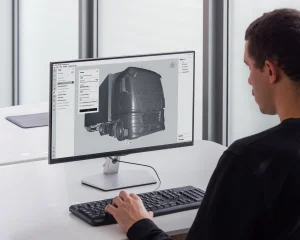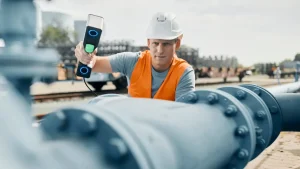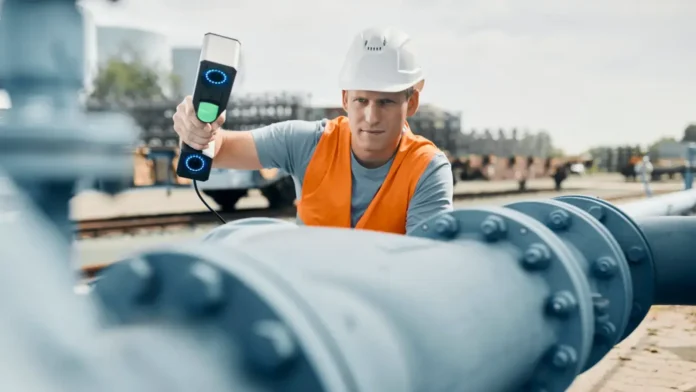Choosing the right 3D scanner for your business can be a daunting task, especially with the vast array of options available on the market today. The key to making the right choice is understanding the specific needs of your projects and how different types of scanners will contribute to your business. At Central Scanning, we can help you do this, and in this comprehensive 3D scanner price guide, we will explore all of the 3D scanners we offer. We will cover essential factors to consider when selecting a scanner, and how to navigate the wide range of options that are available to you.
What affects the price of a 3D Scanner?
When selecting the ideal 3D scanner for your business, it’s crucial to assess several factors to ensure the device meets your specific needs. Here’s a breakdown of the key considerations when choosing a scanner:
- Scan Volume
- The size of the objects you intend to scan is one of the most important factors to consider. If your projects involve small, intricate objects, you’ll need a scanner with a higher resolution to capture the fine details. On the other hand, if you’re working with larger, more complex objects, such as automotive parts or industrial machinery, you’ll need a scanner that can handle large scan volumes without sacrificing accuracy.
- For example, Artec 3D offers excellent solutions for both small and large objects. The Artec Micro II, a desktop scanner, is perfect for scanning small, detailed items, providing an impressive resolution of 10 microns. This makes it ideal for laboratories, reverse engineering, or medical applications, where precision is critical. It can handle objects ranging from the size of a tooth to a tennis ball.
- On the other hand, if you’re working with large-scale objects, the Artec Ray scanner offers a robust solution. It is designed to scan large objects like machinery or architecture with high accuracy, making it ideal for industries that require large-scale scanning solutions.
- Accuracy & Resolution
- Accuracy and resolution are fundamental considerations when selecting a 3D scanner, especially for high-precision applications. Accuracy refers to how closely the scanned object matches the real-world measurements, while resolution dictates the level of detail captured in the scan.
- For instance, Artec 3D scanners such as the Artec Eva offer a balance of resolution and accuracy, suitable for a wide range of industries. However, if your project requires extreme detail, a scanner like the Artec Micro II would be a better option due to its ability to capture the finest details with 10-micron accuracy.
- Scan Speed
- Scan speed is another critical factor, particularly for projects involving large objects or high volumes of scanning. If speed is a priority in your business, choosing a scanner with a faster scan time is essential. While handheld 3D scanners may offer speed and flexibility, desktop and industrial models might provide more accurate scans in less time.
- Portability
- Depending on your scanning environment, portability may be an essential feature. Handheld 3D scanners are often the best choice for businesses that need to scan objects in various locations or field conditions. These scanners are lightweight and easy to transport, but they may not offer the same level of resolution or stability as desktop or industrial systems.
- Ease of Use
- Another key factor in choosing the right 3D scanner is ease of use. Scanners that are difficult to operate or require extensive training can slow down your workflow and may not be the best choice for your business. Many modern 3D scanners come with user-friendly interfaces and intuitive software that make them accessible even to those without technical expertise. When selecting a scanner, ensure that it aligns with your team’s skill set and workflow.
- Post-Processing Software
- The software that accompanies a 3D scanner plays a significant role in the overall user experience. High-quality post-processing software allows for easy editing, mesh repair, and conversion of scans into usable 3D models. For professional-grade scanners, software options like Artec Studio and Geomagic provide a comprehensive suite of tools for refining your scans.

- Support System
- Reliable customer support is crucial when investing in a 3D scanner, especially if you rely on it for essential business operations. Be sure to choose a scanner with a robust support system, including training, troubleshooting, and maintenance services. Central Scanning offers extensive customer support to ensure that you can maximize the performance of your 3D scanner.
3D Scanner Price Ranges
The price of a 3D scanner can vary dramatically depending on several key factors, such as the scanner’s accuracy, resolution, scan volume, and intended use. At Central Scanning, we offer a selection of 3D scanners from top brands like Artec 3D and ZEISS. These scanners come in different types, including handheld, desktop, and industrial models, each offering a unique scanning experience and outcome. The pricing can range from affordable consumer-grade models to high-end industrial scanners capable of scanning larger objects with pinpoint precision.
From our portfolio at Central Scanning, we would consider everything we offer to be professional, high end. If we were to categorise from most budget friendly to enterprise level…

What are the pros and cons of lower cost vs high end?
It really comes down to what your project requires. Handheld scanners are naturally cheaper than industrial scanners, great for on the go, lower cost 3D scanning, still offering high resolution and an unbeatable scanning to CAD operation. Handheld 3D scanners are versatile tools that offer significant flexibility for a variety of applications. Some examples are:
- Reverse Engineering: Handheld 3D scanners are ideal for capturing physical objects and converting them into digital models for redesign or improvement. This is particularly useful for redesigning products without CAD models or when a part no longer has its original blueprint.
- Dimensional Accuracy: Handheld 3D scanners can help ensure that manufactured parts match their design specifications. They’re commonly used in manufacturing and automotive industries to inspect parts and verify tolerances.
- Inspection of Complex Shapes: They can be used to inspect objects with intricate or irregular shapes that might be difficult to measure with traditional tools.
- Orthotics and Prosthetics: In medical applications, handheld scanners are used to capture the shape of body parts to design custom prosthetics or orthotic devices, providing a more accurate and personalized fit.

- Building Scanning: Handheld scanners are commonly used in architecture and construction to scan existing structures and create detailed 3D models of buildings or sites for renovation or planning purposes.
High-end industrial scanners can take your quality control process to a whole new level of simplicity and efficiency. The ZEISS Metrotom 1 is our largest scanner, powered by CT technology it allows you to scan parts non-destructively and explore their internal features. With the ability to measure, analyse, and inspect hidden defects and internal structures, the METROTOM 1, in combination with ZEISS Inspect software, takes your quality control process to a whole new level of simplicity and efficiency.
The METROTOM 1 can be used for:
- Automotive: The ZEISS METROTOM 1 is a highly valuable tool for the automotive industry, offering precise, non-destructive 3D scanning for quality control, reverse engineering, and prototyping. It enables the inspection of internal defects, dimensional accuracy, and wall thickness of automotive parts, ensuring they meet design specifications. The scanner is ideal for analysing 3D-printed components, verifying fit and function of prototypes, and assessing tooling and moulds for production.
- Medical: The METROTOM 1 offers precise, non-destructive 3D scanning capabilities that can be applied across various areas. It can be used for quality control and inspection of medical devices, ensuring parts meet design specifications and are free from internal defects such as cracks or voids. The scanner is also invaluable for reverse engineering medical components, allowing the creation of digital models from existing parts for redesign or replacement. Additionally, it plays a crucial role in implant design and prototyping, enabling the analysis of complex geometries and internal structures for custom implants or prosthetics.
- Reverse engineering: Using its advanced X-ray CT scanning technology, the METROTOM 1 captures both the internal and external geometries of complex parts with high precision. This data can be used to recreate CAD models for parts that lack original design documentation. The scanner is particularly useful for reverse engineering components with intricate internal structures or difficult-to-access areas, such as castings or assemblies. These 3D models can then be used for redesigning, improving existing parts, or creating new prototypes.

How to choose the right 3D scanner for your budget?
If you are considering purchasing a 3D scanner but unsure which is most suitable for your budget, you can contact our team for a full analysis on which scanner will be best suited to your business. Click here to contact a member of our team.
In conclusion, choosing the right 3D scanner for your business requires a careful evaluation of factors such as scan volume, accuracy, resolution, speed, portability, ease of use, post-processing software, and support. Each business has unique needs, whether it’s small, detailed objects or large, complex parts, and selecting the appropriate scanner will significantly impact your workflow and outcomes. At Central Scanning, we offer a wide range of 3D scanning solutions, from budget-friendly handheld models like the Artec EVA Lite to enterprise-level systems like the ZEISS Metrotom 1, ensuring you have the right tools for your projects.
Whether you’re in automotive, medical, or reverse engineering applications, we can help you navigate the options to find the perfect fit for your budget and business needs. Reach out to our team for expert advice and guidance on the best 3D scanner tailored to your specific requirements.
